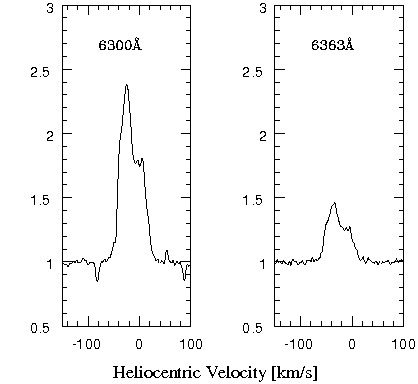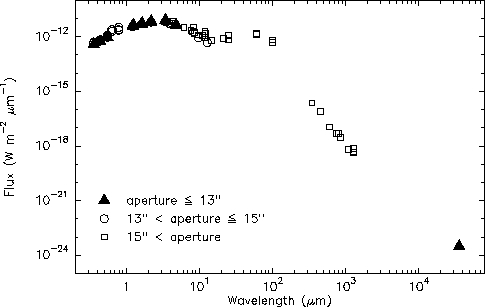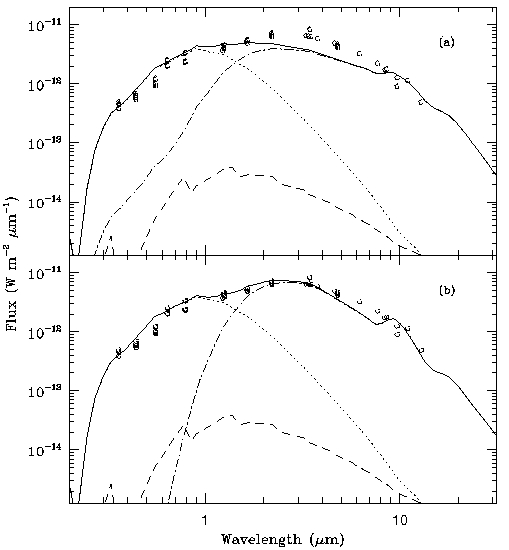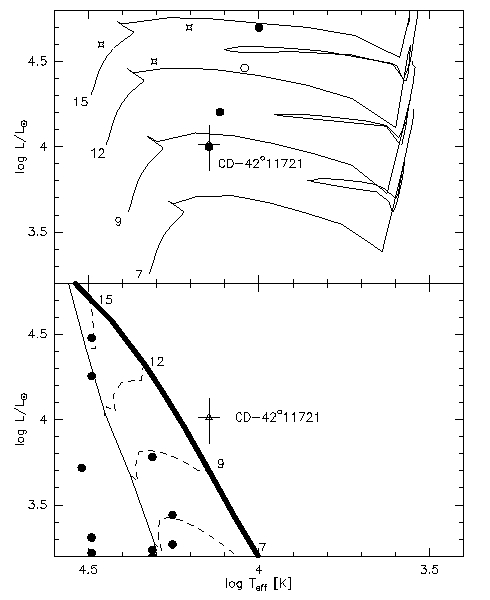To shed light on the real nature of CD-42 11721 we obtained high- and low-resolution optical spectoscopic observations in June 2000 with the Fiber-fed Extended Range Optical Spectrograph (FEROS) and with the Boller & Chivens (B&C) spectrograph, respectively, at the 1.52-m telescope at the European Southern Observatory (ESO) in La Silla (Chile). The FEROS spectrum of CD-42 11721 is completely dominated by emission lines of both permitted and forbidden transitions, and due to the high spectral resolution of FEROS, most of the lines have not been reported earlier. No single photospheric absorption line could be found, indicating that the circumstellar material (CSM) is hiding the star and filling the absorption lines with emission. Interestingly, the emission lines come from mostly singly ionized elements, but many lines from neutral elements like helium and metals like carbon, nitrogen, and oxygen are identified as well.
To understand the structure of the CSM the line profiles can be sorted into three categories: (i) single-peaked, (ii) double-peaked, and (iii) multiple-peaked. No P Cygni lines are identified.
The single-peaked lines clearly dominate and can be found without any exception for every element in every ionization stage, independent whether these are forbidden or permitted lines. If we restrict to the forbidden, hence optically thin lines, we can draw the following conclusions from these lines: (1) The mean wing velocity (which we call the expansion velocity) is of the order of 50-60 km/s and about constant for all forbidden lines, and (2) the line center velocity of all lines is also about constant and of the order of -20 km/s.
Lines showing double-peaked profiles are also wide-spread in the spectra. The blue and red peaks are thereby of equal strength with only rare exceptions, like the [OI] lines at 6300 Å and 6363 Å, for which the red peak is missing as obvious from the following figure.

The peak separation of all double-peaked lines ranges from 30 to 50 km/s. Interestingly, the double-peaked profiles are present only for neutral metals (like O I, N I, C I, and S I) and ions with ionization potential below about 8 eV, for instance Fe II, Mg II, and Cr II. This maximum ionization potential is well below the one for hydrogen, which implies that
(1) the emitting material must be neutral in hydrogen, and
(2) the double-peaked profile might indicate rotation or equatorial outflow.
Combination of both seems to suggest the existence of a neutral (in hydrogen) rotating disk or an equatorially outflowing wind. The double-peaked profiles are not restricted to permitted transitions but are present in several forbidden lines from [O I], [Cr II], and many lines of [Fe II].
Multiple-peaked profiles are found especially for permitted emission lines of Fe II where three peaks or more are observed. The existence of such multiple-peaked lines favours a highly complex multi-component emission region.
The stellar parameters of CD-42 11721
Effective temperature: The FEROS spectrum has the highest resolution of all spectra obtained for CD-42 11721 so far. Hence we are in a much better position to determine a reliable set of stellar parameters. The presence of He I emission lines but the absence of He II lines limits the effective temperature between 13 000 K and 30 000 K. Checking the ionization potentials of all identified lines reveals that all lines come from ionization stages with an ionization potential below 25 eV. No lines from ionization stages higher than 27 eV show up in our spectrum for which lines from Ar III, N III, and Cl III would be ideal tracers. Hence we can limit the degree of ionization to a narrow range in ionization potential, i.e. between 25 and 27 eV. This range is just above the helium ionization potential so that the effective temperature of CD-42 11721 should be much closer to the lower limit at 13 000 K rather than to the upper limit at 30 000 K. In addition, in order to reproduce the shape of the optical continuum as given by the flux-calibrated B&C spectrum, we found a maximum possible effective temperature of 15 000 K, constraining the effective temperature of CD-42 11721 to 14 000±1 000 K.Distance: The most controversial parameter of CD-42 11721 found in the literature, is its distance. The values range from as close as 136 pc up to as far as 2.6 kpc. Our FEROS spectra display the interstellar absorption lines of Na I and Ca II. From the equivalent widths of these lines, we could determine, for the first time, a proper distance to CD-42 11721 of 1.15±0.15 kpc.
Interstellar extinction: The value of the interstellar extinction is believed to be quite high, and literature values range from 4.2 mag to 7.1 mag. To derive the extinction from our data, we use line ratios of the hydrogen Paschen lines over the hydrogen Balmer lines. The red edge of the FEROS spectrum displays well-resolved Paschen lines from Pa(10) up to Pa(40), while at the blue edge of the FEROS spectrum we observe the Balmer lines up to H9. From the line ratios and the simultaneous fitting of the line luminosities, we obtain an extinction value of 4.8±0.2 mag towards CD-42 11721.
Stellar radius and luminosity:The stellar radius can be obtained from fitting the flux-calibrated and de-reddened low-resolution B&C spectrum with classical Kurucz model atmospheres using the effective temperature, distance, and varying the values of the surface gravity (log g). This delivers a value for the stellar radius of 17.3±0.6 times the solar radius, and a surface gravity of log g = 3.0. Hence the stellar luminosity amounts to 10 000± 3 000 solar luminosities.
Modeling the spectral energy distribution (SED)
To construct a proper SED, we collected from the literature all available photometric data. However, caution should be taken when using data obtained with different instruments having different aperture sizes. Instruments like IRAS or ISO-SWS and even MSX have apertures in excess of 15 arcsec, meaning that not only the close-by CSM was observed, but the data are contaminated by the much larger reflection nebula around CD-42 11721 and even by neighboring stars. Consequently, the constructed SED might be misleading. In fact, comparing SEDs using data taken with different aperture sizes, it turns out that CD-42 11721 shows a double-peaked SED when the differences in aperture sizes are ignored (see the following figure). Such a double-peaked SED is well-known (and correct) for a sub-group of Herbig Ae/Be stars. We assume that this is why CD-42 11721 could have been misclassified as a possible Herbig Ae/Be star in the past.
We restrict our analysis to data taken with aperture sizes smaller than about 15 arcsec. To model the SED, we applied different dust distributions like a spherical dust shell, a passive, flared disk as is expected for a Herbig Ae/Be star, and a disk formed by an equatorially outflowing wind as is expected for an evolved object. Especially for the treatments of the disks we developed our own radiative transfer code that computes the inner edge of the disk, as well as the shape of the disk and its vertical temperature structure self-consistently. The dust is assumed to consist of a amixture of amorphous carbon and silicates, and we apply the typical MRN grain size distribution.
We find that a spherical dust shell is not able to reproduce the observed SED. This is not unexpected, because from the variety in observed line profiles we concluded already that the star might be surrounded by a neutral disk. This disk would naturally be the location of the dust. The results for the flared disk and the outflowing disk-forming wind are shown in the top and bottom panel of the following figure, respectively. The circles represent the observed photometric data. The total fit in each panel (shown as solid line) consists of the contributions from the stellar photosphere (dotted line), the free-free and free-bound emission from the ionized wind (dashed line), and the dusty disk (dashed-dotted line).

The comparison between our best fits obtained from either a flared disk and the outflowing disk-forming wind suggests that the latter (although also not perfect) might be the better solution. Especially, because it fits the mid-infrared data much better that the flared disk scenario.
The nature of CD-42 11721
The determination of a revised set of stellar parameters and the results from the SED fitting allows us now to discuss the most plausible evolutionary phase of CD-42 11721. According to its effective temperature and luminosity, we can plot the location of the star within the empirical Hertzsprung-Russell diagram (HRD) for either a pre-main sequence (Herbig Ae/Be star) or a possible post-main sequence scenario. This is shown in the next figure with the pre-main sequence scenario in the bottom panel, including the locations of the birthline (fat solid line), the pre-main sequence evolutionary tracks for medium-mass stars (dashed lines), and the zero-age main sequence (thin solid line). Known Herbig Ae/Be stars are shown by the black dots. Obviously, CD-42 11721 is located above the birthline and therefore does not fall into the allowed range for Herbig Ae/Be stars, meaning that its classification as a pre-main sequence star can be discarded.
From the top panel of that figure, it follows that CD-42 11721 fits well into the post-main sequence domain of the HRD, in which we also find the typical B[e] supergiants. In fact, its location (shown as a triangle) falls on top of the lowest luminosity B[e] star in the LMC (filled circle). Compared to the other possible Galactic B[e] supergiants (shown as asterisks) it seems that CD-42 11721 would be the first confirmed low-luminosity galactic B[e] supergiant. The finding from the SED modeling, which favours an outflowing disk-forming wind scenario, is in perfect agreement with the classification of CD-42 11721 as post-main sequence object, i.e. as a B[e] supergiant.